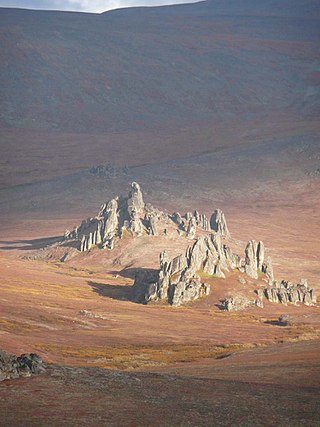
Trout is a generic common name for numerous species of carnivorous freshwater ray-finned fishes belonging to the genera Oncorhynchus, Salmo and Salvelinus, all of which are members of the subfamily Salmoninae in the family Salmonidae. The word trout is also used for some similar-shaped but non-salmonid fish, such as the spotted seatrout/speckled trout.

The McCloud River is a 77.1-mile (124.1 km) long river that flows east of and parallel to the upper Sacramento River, in Siskiyou County and Shasta County in northern California in the United States. Protected under California's Wild and Scenic Rivers Act (1972), it drains a scenic mountainous area of the Cascade Range, including part of Mount Shasta. It is a tributary of the Pit River, which in turn flows into the Sacramento River. The three rivers join in Shasta Lake, formed by Shasta Dam north of Redding.

The bull trout is a char of the family Salmonidae native to northwestern North America. Historically, S. confluentus has been known as the "Dolly Varden", but was reclassified as a separate species in 1980. Populations of bull trout in the lower 48 states are listed as threatened under the U.S. Endangered Species Act, and bull trout overall are listed as vulnerable to extinction on the IUCN Red List of Threatened Species. The Saskatchewan-Nelson Rivers population in Alberta, Canada is listed as threatened under the Species at Risk Act.
Dolly Varden may refer to:

The Arctic char or Arctic charr is a cold-water fish in the family Salmonidae, native to alpine lakes, as well as Arctic and subarctic coastal waters in the Holarctic.

Sea trout is the common name usually applied to anadromous (sea-run) forms of brown trout, and is often referred to as Salmo trutta morpha trutta. Other names for anadromous brown trout are bull trout, sewin (Wales), peel or peal, mort, finnock (Scotland), white trout (Ireland), Dollaghan and salmon trout (culinary).

The silver trout is an extinct char species or subspecies that inhabited a few waters in New Hampshire in the United States prior to 1939, when a biological survey conducted on the Connecticut watershed by the New Hampshire Fish and Game Department found none.
Salvelinus curilus is a species of anadromous fish in the salmon family. It inhabits the waters of Russian Far East in the Kurile Islands, Sakhalin, Primorye and also Korea and Japan. It has mostly been considered a subspecies of the Dolly Varden trout Salvelinus malma, with the name Salvelinus malma krascheninnikova, and referred to as the southern Dolly Varden or Asian southern form Dolly Varden trout.

Salvelinus is a genus of salmonid fish often called char or charr; some species are called "trout". Salvelinus is a member of the subfamily Salmoninae within the family Salmonidae. The genus has a northern circumpolar distribution, and most of its members are typically cold-water fish that primarily inhabit fresh waters. Many species also migrate to the sea.

The Koyuk River is a river on the Seward Peninsula of western Alaska, in the United States. The river originates in the interior of the peninsula, at the Lost Jim Lava Flow of the Bering Land Bridge National Preserve, where it flows southeast towards the mouth of Norton Bay on Norton Sound. The native village of Koyuk is located at its mouth. The two major tributaries are the Peace and Salmon rivers; other tributaries include Dime and Sweepstakes.
The angayukaksurak char is a type of salmonid fish found in Alaska in a few select Brooks Range headwaters.

The Sunapee trout, also called blueback trout, Sunapee Golden trout, or Quebec red trout, is a putative subspecies of Arctic char native to northeastern New England in the United States, as well as Québec and New Brunswick in Canada, with introduced populations in Idaho.

A kype is a hook-like secondary sex characteristic which develops at the distal tip of the lower jaw in some male salmonids prior to the spawning season. The structure usually develops in the weeks prior to, and during, migration to the spawning grounds. In addition to the development of the kype, a large depression forms in the two halves of the premaxilla in the upper jaw, allowing the kype to fit into the premaxilla when the mouth is closed.
Salvelinus albus, also known as white char, is a species of freshwater fish in the salmon family. It is endemic to the Kamchatka Peninsula, Russia, including the Lake Kronotskoye drainage basin.
Salvelinus vasiljevae, commonly known as Sakhalinian char, is a species of freshwater fish in the salmon family. It is found in the wider Sakhalin region from Nevelskoy Strait and the Amur river basin.















